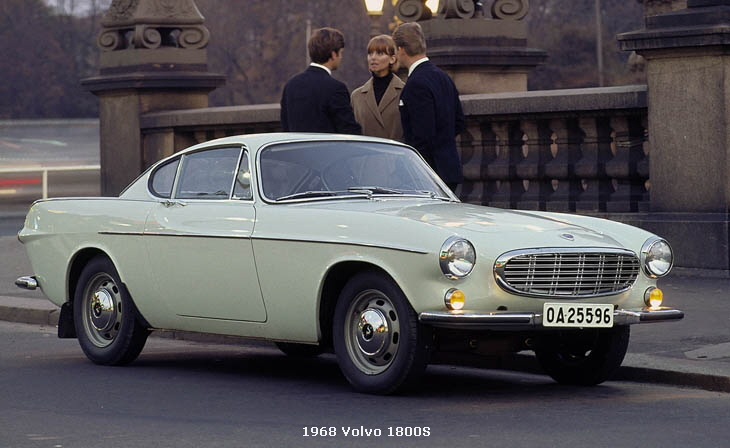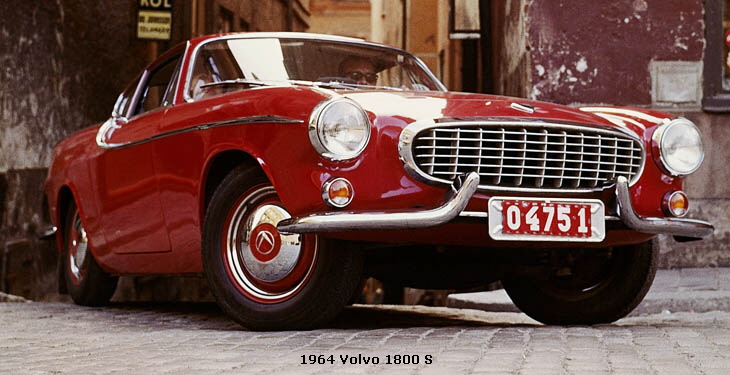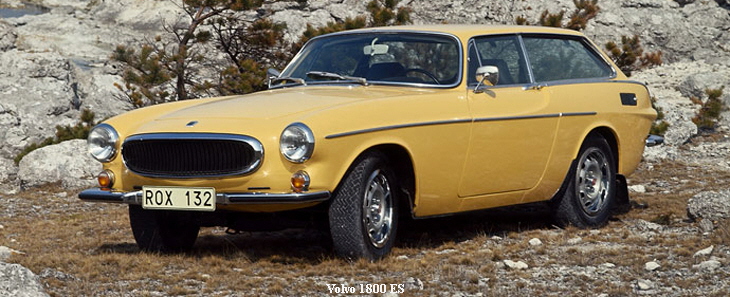|
|
|
VOLVO P1800/1800 IN PRODUCTION 1961-1972 Early in 1959, Volvo presented a new sports car, two years after the previous attempt with the Volvo Sport, with a body made of fibreglass-reinforced polyester. The new car became known as the P1800, with later designations being P1800S/1800S and 1800E. This new sports car had Italian styling and production began in 1961. As Volvo did not have the capacity to build the car itself, production during the first years was contracted to England. A company called Pressed Steel made the bodies, while final assembly took place at Jensen. Assembly of the P-1800 S was then transferred to Göteborg and Lundbyverken 1963. Body production too was transferred to Sweden and Olofströmsverken. This was in connection with the 1800 E in 1969. The Volvo P1800 was based on the floor pan of the Volvo 121/122S, but it had a shorter wheel base. The car also had an entirely new 1.8-litre, 4-cylinder engine, which initially developed 100 bhp, later 108, 115 and 120 bhp. Over the years, the car was developed primarily by the introduction of new engine alternatives. In the autumn of 1968, a 2.0-litre engine with an output of 118 bhp was introduced. It was followed in 1969 by a version with fuel injection and an even higher output. TECHNICAL SPECIFICATIONS
Engine: 4-cylinder, in-line, overhead valves, 1,778 cc, 84.14 x 80 mm, 100 bhp at 5,500 rpm, increased in 1968 to 108 bhp at 5,800 rpm. A 2.0-litre, 1,986 cc ( 88.9 x 80 mm), carburettor version appeared in 1968, followed by a fuel-injection version in 1969, 120 bhp. Transmission: 4-speed manual or 4-speed manual with overdrive or a 3-speed automatic, all with a floor-mounted gear lever. Brakes: Hydraulic, discs at front and drums at rear, later models had discs for all wheels. Dimensions: Overall length 440 cm,wheelbase 245 cm. Misc: This Volvo model became very famous as a result of its role in the films about "The Saint" in which the hero Simon Templar (Roger Moore) drove the car.
A TRUE COSMOPOLITAN TURNS 50 - VOLVO P1800 1961 Planned in Sweden, designed in Italy, unveiled at the car show in Brussels, built in Britain and a huge success in the USA. The Volvo P1800 is perhaps Volvo's most internationally renowned model ever and the one that arouses most emotions. In 2011 this remarkable people's favourite turns 50. It was in 1961 that it entered production and reached showrooms after four years of careful planning and development, remaining in production for the next twelve years. From the sales perspective it played perhaps a marginal role for the company, but from the image viewpoint it played a far bigger role than any previous Volvo model. Design Coup Volvo had tried its hand at a sports car back in the early 1950s – the open two-seater plastic-bodied Volvo Sport which was built from 1955 to 1957 with a total production run of just 67 cars. "Not a bad car, but a bad Volvo" was the way Volvo President Gunnar Engellau put it when he retired the model. However, he did recognise the importance of having a prestigious and exciting model to boost overall sales, and Volvo dealers were desperate for just such a car. Design proposals were ordered from Italy, where Volvo consultant Helmer Petterson – who was deeply involved in the planning of the new car – had got his son Pelle a job at Pietro Frua thanks to Pelle's fresh degree in industrial design from the Pratt Institute in New York. When the time came to unveil the four proposals to Volvo's board in 1957, Helmer sneaked in his son Pelle's fifth design – and that was the one that everyone picked. Engellau in particular liked it since he had very definite views about wanting an Italian-designed car. That of course is precisely what he did get, but it was penned by a 25 year old native of Göteborg who would later make his mark as a boat designer and win Olympic medals in yacht racing. Eventually, however, the truth behind the winning design proposal emerged. The choleric Engellau blew his top, felt he had been hoodwinked and promised that Pelle would never be acknowledged as the car's designer. And indeed many years went by before the truth was made known and Pelle Petterson received the credit he was due for penning one of the world's most attractive sports coupes. The new sports car – which is how Volvo presented the model – had a fixed roof, a steel body, a lot of the mechanical components lifted straight from the Amazon and the newly developed B18 engine in its 100 hp sports version when it eventually arrived in the showrooms. Three prototypes were built by Frua in Turin in 1957-1958 on Amazon underpinnings and these cars were used for a variety of purposes, for instances as templates for the production of press tools, in a range of tests, at shows, for press work and advertising photo-shoots and much else. All three have survived and are still on the road. Production Overseas As of spring 1963 – after 6000 Jensen-built cars – production of the 1800 started up in Volvo's Lundby factory but it was not until 1969 that body pressings were transferred from Pressed Steel in Scotland to Volvo's press shop in Olofström. The move home also coincided with a change of name for the P1800. First it was badged the P1800 S, later in 1963 it was known simply as the 1800 S, S standing for Sweden. During the coupe's long life, no radical changes were made to the successful exterior lines. Only details such as the grille, trim mouldings, wheels and colours differentiate the various model years. From the technical viewpoint the 1800 shadowed the development of Volvo's other models and was continuously upgraded. Disc brakes all round, more powerful engines and electronic fuel injection were the most noticeable changes. Cult Car for The Saint and a World Record-Holder Just ask Roger Moore, who was fortunate enough to drive a P1800 in his role as debonair crime-fighter Simon Templar, a sort of modern-day Robin Hood, in the British TV drama series based on Leslie Charteris's "The Saint". The TV production company was looking for an attractive sports car that would suit a gentleman of independent means, and after being turned down by Jaguar approached Volvo to ask for the P1800. Volvo was quick to oblige. It was a brilliant PR move for the new Volvo model and the car became etched firmly in the minds of everyone at the time. To this day the P1800 is still often referred to as The Saint's car. Another person who can testify to the car's excellence is New Yorker Irv Gordon, who has covered more than 4,500,000 kilometres in the 1800 S he purchased in 1966, making him the holder of a Guinness world record that will probably never be able to be beaten. Irv Gordon has spent a total of almost 12 years behind the wheel of his car and he is now aiming for 3,000,000 miles, that is to say about 4,800,000 kilometres. On the same engine! Timeless 50 Year Old
|
|
|
|



